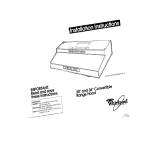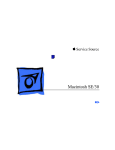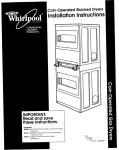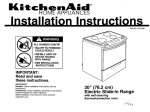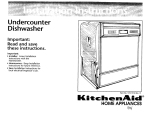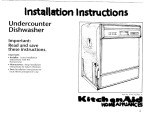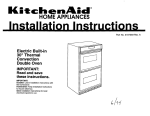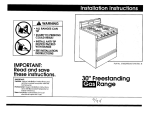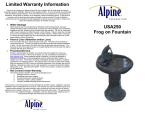Download Quick Reference
Transcript
Quick Reference Table of Contents: Pages 111 Before you start El Product dimensions 111 Cabinet dimensions/requirements 121 Electrical requirements m-151 Installation steps IBackeover] If range does not operate 1-. Back cover1 JBatkcoverl If YOU need assistance/service Moving the range If you need assistance: Check your Use and Care Guide for a toll-free number to call or call the dealer from whom you purchased this appliance. The dealer is listed in the Yellow Pages of your phone directory under “Appliances Household - Major - Service and Repair.” Call when you: Q Have questions about range installation or operation. q Need to obtain the name and number of an authorized service company. When you call, you will need: q The range model number. m The range serial number. -+%Q Both numbers are listed on the model/serial rating plate located on the oven frame behind the storage drawer panel. Important: Observe all governing codes and ordinances. Proper installation is your responsibility. A qualified technician must install this range. Make sure you have everything necessary for correct installation. It is the installer’s responsibility to comply with installation clearances specified on the model/serial rating plate. The model/serial rating plate is located on the oven frame behind the storage drawer panel. Check location where range will be installed. The range should be located for convenient use in kitchen. ALL OPENINGS IN THE WALL OR FLOOR WHERE RANGE IS TO BE INSTALLED MUST BE SEALED. Cabinet opening dimensions that are shown must be used. Given dimensions are minimum clearances. Grounded electrical outlet is required. See “Electrical requirements,” Page 2. 27-l/8” depth with handle 46.718” overall height i 36” cooktop height I Electrical Shock Hazard It is the customer’s responsibility to contact a qualified electrical installer and to make sure that the electrical installation is adequate and in conformance with National Electrical Code, ANWNFPA 70 -latest edition*, and all local codes and ordinances. Take special care when cutting holes in wall or iloor. Electrical wires may be behind the wall or iloor covering and could cause an electrical shock if you touch them. Locate any electrical circuits that could be affected by the installation of this product and disconnect power circuit. Failure to follow these instructions could result 30” min. cabinet opening width -4 For minimum clearance to the top of the cooktop, see Note.** K/ n death or serious injury. Injury Hazard Toeliminate the risk of burns or fire avoid nstalling cabinet storage above the cooking surface. If cabinets are already installed, reduce :he hazard of reaching over a heated cooking surface by installing a range hood. The range load should extend a minimum of 5 inches out rom the bottom front of the cabinets. qeaching over a heated cooking surface could esult in a serious burn or other injury. 5-l/2” max. Do Not pinch the power supply cord between the range and the wall. Wall receptacle V to 22” from eftber cabinet, S-112” max. from floor. Position receptacle as shown. Do Not seal the range to the side cabinets. : IIF J Mobile home installation The installation of this range must conform with the Manufactured Home Construction and Safety Standard, Title 24 CFR, Part 3280 [formerly the Federal Standard for Mobile Home Construction and Safety, Title 24, HUD (Part 28011or, when such standard is not applicable, the Standard for Manufactured Home Installations, ANSI A225.1/NFPA 501A, or with local codes. When this range is installed in a mobile home, it must be secured to the floor during transit. Any method of securing the range is adequate as long as it conforms to the standards listed above. Four-wire power supply cord or cable must be used in a mobile home installation. The appliance wiring will need to be revised. See “Four-wire electrical cOnnectiOn,n Page 3. r \ **Note: 24” min. when bottom of wood or metal cabinet is protected by not less than l/4” flame retardant millboard coveted with not less than No. 28 MSG sheet steel, 0.015” stainless steel, 0.024” aluminum or 0.020” copper. 30” min. clearance between the top of the cooking platform and the bottom of an unprotected wood or metal cabinet. Anti-t ip bracket The floor-mou ted anti-tip bracket MUST be installed. To install the anti-tip bracket shipped with the range, see Page 2 and the anti-tip bracket template/instruction sheet Copies of the standards listed may be obtained from: * National Fire Protection Batterymarch Park Quincy, Massachusetts Association 02269 2 plastic anchors bR)6 concrete/ceramic floors: 3/16” carbide-tipped masonry drill bit (Hammer may be needed for anchors.) Page 1 O screws (MO x 1-l/2”) floor-mounted anti-tip bracket Not shown: literature pack 3 brass terminal block nuts Brackets must be securely mounted to sub-floor. Thickness of flooring may require longer screws to anchor bracket to subfloor. longer screws are available from your local hardware store. Range must be connected to the proper electrical voltage and frequency as specified on the model/serial rating plate. (The model/serial rating plate is located on the oven frame behind the storage drawer panel.) q CONNECT WITH COPPER WIRE ONLY. j7J A three-wire or four-wire, single-phase, 120/240volt, 60-Hz, AC-only, electrical supply (or three-wire or four-wire 120/208-volt if specified on the model/serial rating plate) is required on a separate, 40-ampere circuit, fused on both sides of the line. Electrical Shock Hazard Electrical ground is required on this range. Do Not ground to a gas pipe. Do Not change the power supply cord plug. lf it does not fit the outlet, have a proper outlet installed by a qualified electrician. Do Not have a fuse in the neutral or grounding circuit. A fuse in the neutral or grounding circuit could result in electrical shock. Do Not use an extension cord with this appliance. Check with a qualified electrician if you are not sure the range is properly grounded. Failure to follow these instructions could result in death or serious injury. If codes permit and a separate grounding wire is used, it is recommended that a qualified electrician determine that the grounding path is adequate. Power supply cord is not supplied, but is available through your local electrical supply house. q A time-delay fuse or circuit breaker is recommended. q Local codes may permit the use of a U.L.-listed, 250~volt, 40-ampere range power supply cord (pigtail). This cord contains three, No.-10 copper wires and matches a three-wire receptacle of NEMA Type lo-50R, shown in Figure 1. Connectors on the appliance end must be provided at the point the power supply cord enters the appliance. q The range can be connected directly to the fused disconnect (or circuit breaker box) through flexible, armored or non-metallic sheathed, copper cable (with grounding wire). Allow two to three feet of slack in the line so that it can be moved if servicing is ever necessary. If connecting to a four-wire system: This range is manufactured with the ground connected to the cabinet. The ground must be revised so the green grounding wire of the fourwire power supply cord is connected to the cabinet. See “Four-wire electrical connection,” section, Page 3. When a four-wire receptacle of NEMA Type 1450R is used (see Figure 21, a matching U.L.-listed, four-wire, 250-volt, 40-ampere, range power supply cord (pigtail) must be used. This cord contains four copper conductors with ring terminals at the appliance end, terminating in a NEMA Type 14-50P plug on the supply end. The fourth (grounding) conductor must be identified by a green or green/yellow cover and the neutral conductor by a white cover. Cord should be Type SRD or SRDT with a U.L.-listed strain relief and be at least four feet long. The MINIMUM conductor sizes for the copper four-wire power cord are: 40-ampere circuit 2, No.-8 conductors 1, No.-10 white neutral 1, No.-8 green grounding A U.L.-listed conduit connector must be provided at each end of the power supply cable (at the range and at the junction box). Wire sizes (COPPER WIRE ONLY) and connections must conform with the rating of the range (40-amperes). q 3.wire wall receptacle (lo-50R) The wiring diagram is located on the back of the range or on the inside of the storage drawer in a clear plastic bag. Figure 1 4-wire wall receptacle (14-50R) Figure 2 front leveling leg Because of the weight and size of this range, two or more people are required to move it. Do Not use handle for lifting. w these instructions could 1 cardboard shipping b 2 n Do Not remove the cardboard shipping base at this time. Put on safety glasses and gloves. Remove oven racks and parts package from inside oven. Remove shipping materials, tape and protective film from range. 3 n Remove storage drawer. Use a 31 drive ratchet to lower rear leveling legs onehalf turn. Use channel lock pliers to lower front leveling legs one-half turn. n Anti-tip bracket installation Electrical Shock Contact a qualified floor covering installer for the best procedure for drilling mounting holes through your type floor covering. Injury Hazard Take special care when drilling holes in To reduce the risk of tipping, the range the floor or wall. Electrical wires may be located beneath the floor or behind the wall. Locate the electrical circuits that could be affected by the installation of the anti-tip bracket and turn off power to these circuits. Failure to follow these instructions could result in death or serious injury. must be secured by a properly installed floor-mounted anti-tip bracket, supplied with the range. Save these Installation Instructions. If the range is moved to a new location, the anti-tip bracket must be removed and reinstalled in the new location. Failure to follow these instructions could result in injury. 4 Use the anti-tip bracket template/instruction sheet to install the anti-tip bracket. Anti-tip bracket must be anchored securely to the sub-floor. Depending on the thickness of your flooring, longer screws may be necessary to anchor the bracket to the sub-floor. Longer screws are available from your local hardware store. n Check that range is on cardboard shipping base to protect floor covering. 5 n position. Page 2 Move range close to final operating Electrical connection Three-wire electrical connection: silvercolored terminal block screw. rr ,t IuH\\l,grounding link \\’ -I Electrical Shock Hazard Electrical ground is required on this range. Do Not connect to the electrical supply until the range is permanently grounded. Disconnect the power to the junction box before making the electrical connection. This range must be connected to a grounded, metallic, permanent wiring system or a grounding connector should be connected to the grounding terminal or wire lead on the range. Failure to follow these instructions could result in death or serious injury. Pull cover down and remove. l-l UL-listed strain relief and 40-ampere range power supply cord I- I Figure 3 Use this method ONLY if local codes PERMIT connecting cabinet-grounding conductor to neutral wire of power supply cord. 7. Use the brass terminal nuts attached to the inside of the terminal block cover to connect the neutral wire (center wire) to the silver-colored terminal screw on the terminal block. See Figure 3. 8. Connect the other two wires to outer terminal screws on the terminal block. See Figure 3. 9. Do Not loosen factory-installed nuts already on the terminal. Tighten nuts with 3/8’ nut driver for proper electrical connection. 10. Tighten the strain relief screws. 11. Replace the terminal block cover. 12. Plug power supply cord into grounded electrical outlet. This range may be connected directly to the fuse disconnect or circuit breaker box; or with a U.L.-listed, 40.ampere range power supply cable. Depending on your electrical supply, make the required three-wire or four-wire connection. 1. Disconnect the power supply. 2. Remove the knock-out for the power supply cable. 3. Assemble a U.L.-listed conduit connector in the power supply cable opening. 4. Strio outer coverinn back 3 inches connector. from end, exposing wires. Strip the insulation back 1 inch from the end of each wire. 5. Form the bare wire into a “U” shaped hook. 6. Insert the power supply cable through the conduit connector, allowing enough slack to easily attach the wiring terminal block. 7. Complete electrical connection according to your type electrical supply (“Three-wire electrical connection” or “Four-wire electrical connection.“) Three-wire electrical connection: silver-colored /terminal block screw grounding link ne 2 line 1 neutral (white wire) -~ terminal block cover Four-wire electrical connection: Figure 6 U.L-listed conduit connec tor and power supply cable. Use this method ONLY if local codes PERMlT connecting cabinet-grounding conductor to neutral wire of power supply cable. Figure 4 screws 6 Remove the terminal block cover screws n located on the back of range. Pull cover down and towards you to remove cover from range. Depending on your electrical supply, 7 n make the three-wire or four-wire connection following the “Power supply cord method” or “Direct wire method” instructions. grounding grounding-link ,screw silver-colored terminal block screw I link - ?\ 8. Use the brass terminal nuts attached to the inside of the terminal block cover to connect the neutral wire (white wire) to the silver-colored terminal screw on the terminal block. See Figure 6. 9. Connect the other two wires to outer terminal screws on the terminal block. See Figure 6. 10. Do Not loosen factory-installed nuts already on the terminal. Tighten nuts with 3/8’ nut driver for proper electrical connection. 11. Tighten the locking ring and clamping screws of the conduit connector. 12. Reolace the terminal block cover. Four-wire electrical connection: l-amen wire (center groundinglink screw lin This range is manufactured with the neutral terminal connected to the cabinet. Use a threewire, U.L.-listed, 40-ampere power supply cord (pigtail); or if local codes Do Not permit grounding through the neutral, use a four-wire power supply cord rated at 250 volts, 40-amperes and investigated for use with ranges. (See “Fourwire electrical connection.“) remove knockout Gus::: 1. Disconnect the power supply. 2. Remove the knockout for the 40-ampere power supply cord. 3. Assemble a U.L.-listed strain relief in the opening. 4. Insert the power supply cord through the strain relief, allowing enough slack to easily attach the wiring to the terminal block. 5. Use only ring-type terminals to connect the power supply. To secure the power supply cord, use the 3/8’ brass terminal nuts attached to the inside of the terminal block cover. Be sure nuts are installed tight. 6. Complete electrical connection according to your type electrical supply (“Three-wire electrical connection” or “Four-wire electrical connection.“) Page 3 - - ain relief re range power supply cord Figure 5 Use this method for mobile homes and whenever four-wire installation is required. 7. Remove the grounding-link screw from the range frame. Save the grounding-link screw. Bend up the grounding link so that it does not contact the range. See Figure 4. 8. Connect the green grounding wire from power supply cord to the range using the grounding-link screw. The grounding wire must ba attached first and must not contact any other terminal. See Figure 5. 9. Connect the neutral wire (center wire) to the center, silver-colored terminal screw on the terminal block using the brass terminal nuts that are attached to the inside of the terminal block cover. See Figure 5. 10. Connect the other two wires to the outer terminals on the terminal block. See Figure 5. 11. Do Not loosen the factory installed nuts already on the terminal. Tighten nuts with 3/8’ nut driver for proper electrical connection. 12. Tighten the strain relief screws. 13. Replace the terminal block cover. 14. Plug power supply cord into grounded electrical outlet. / 44ver-colored terminal block screw neutral wire connector and Use this method for mobile homes and whenever four-wire installation is required. 8. Remove the grounding-link screw from the range frame. Save the grounding-link screw. Bend up the grounding link so that it does not contact the range. See Figure 7. 9. Connect the bare grounding wire from power supply cable to the range using the groundinglink screw. The grounding wire must be attached first and must not contact any other terminal. See Figure 8. 10. Connect the neutral wire (white wire) to the center, silver-colored terminal screw on the terminal block using the brass terminal nuts that are attached to the inside of the terminal block cover. See Figure 8. 11. Connect the other two wires to the outer terminals on the terminal block. See Figure 8. 12. Do NOT loosen the factory installed nuts already on the terminal. Tighten nuts with 3/8’ nut driver for proper electrical connection. 13. Tighten the locking ring and clamping screws of the conduit connector. 14. Replace the terminal block cover. Check that Connect power supply cord or power supply cable nemove shipping -..C--Ll Remove oven racks and parts nsl.-LS.“* I I__ . ..I - .i Install antitip bracket Sfcure range with anti-tip bracket Level range LOosen leveling Operating position iBeforemoving range across floor, check that range is still on cardboard shipping base to protect floor covering. 8 IC. .1 11Mailing the range in a mobile l home, YOUMUST secure the range to the floor. Any method of securing the range is adequate as long as it conforms to the standards in the “Mobile home installation” instructions, Page 1. IC I Mo\le the range into final operating posltlofl. Remove cardboard shipping base from under range. l Place rack in Oven. Place level on rack, first side to side; then front to back. 9 8 Check that rear leveling leg is engaged in M-tip bracket. lf range iS not level, pull range forward until rear leveling kg is removed from the anti-tip bracket Use 38’ drive ratchet and channel lock pliers to ’ adjust leveling legs up or down until range is level. Push range back into position. Check that rear leveling leg is engaged in anti-tip bracket, Note: Oven must be level for satisfactory baking conditions, Page 4 Check operation FRONT 13 CLOSE OFF DOOR I Check the operation of the cooktop elements: Push in and turn each surface unit control knob to “HI” position. Check the operation of the cooktop elements and indicator lights. 14 n Check the operation of the oven and broil elements: Follow the instructions for your type oven controls. n If your oven has electronic control pads (with or without timer): OVEN ON 0 (nmcfFOMNW~NFL*SHKG, 1. Press the “BAKE” pad. *The “BAKE” indicator will light “350” will appear in the display. The “START ?” indicator will begin to flash after 5 seconds. l CLEAN. The oven is preheated when the “PREHEAT” indicator light goes off (console A only), you hear a l-second tone and the countdown changes to “350”. * Note: “PREHEAT” indicator light will not be displayed if oven temperature is over 170°F. l OVEN HEATING 0 y&” BROIL. l DOO~~L~CXE&CL~A~~~, 2. Press the START/ENTER pad. The “PREHEAT” or “HEAT,” and “ON” indicators will light. The display will show the automatic countdown time (6 minutes) needed to preheat the oven for selected temperature. The bottom element should glow red. The upper element should become hot, but not glow red. l l If your range has oven temperature control knob: 1. Set the oven temperature control to 350°F. The bottom element should glow red and the “OVEN ON” and “OVEN HEATING” indicator lights should be on. The upper element should become hot but not glow red. The “OVEN HEATING” indicator light goes off when the oven is preheated. l l l 3. Press the “OFF/CANCEL” pad. 4. Press the “CUSTOM BROIL” pad. “500” will appear in the display. The “BROIL” indicator will light. The “START ?” indicator will begin to flash after 5 seconds, l l l 5. Press the “START/ENTER” pad. The “ON” and “HEAT” (console B only) indicators will light. The upper element should glow red. l l 6. Press the “OFF/CANCEL” pad. l 2. Set the oven temperature control to “BROIL.” The upper element should glow red and the “OVEN ON” and “OVEN HEATING”indicator lights should be on. l 3. Turn the control knob to the “OFF” position. OFF . BROIL . BAKE . !m* -.--wOFF . BROIL . e l 200 450 l . / . 400. , _ . 350 ’ 300 \ 250 If your range has oven selector and temperature control knobs, D If your oven has electronic control pads and a timer: 1. Press the “BAKE” pad. The “BAKE” indicator will light “350°F” will appear in the display. The “START ?” indicator will begin to flash after 5 seconds (console D only). l l l 2. Press the START/ENTER pad. “PrE” and “4:15” will appear in the display. “HEAT” and “ON” and indicators will light. The bottom element should glow red. The upper element should become hot but not glow red. l l 1. Set the oven selector control to “BAKE” and the oven temperature control to 350”. 9The bottom element should glow red and the indicator light should be on. The upper element should become hot but not glow red. The oven indicator light goes off when the oven is preheated. l l The oven is preheated when the time in the display counts down to “O:OO,” you hear a l-second tone, and “PrE” changes to “350°F.” 3. Press the “OFF/CANCEL” pad. 4. Press the “CUSTOM BROIL” pad. “500°F” will appear in the display. “BROIL” indicator will light. The “START ?” indicator will begin to flash after 5 seconds (console D only). l l l 5. Press the “START/ENTER” pad. “HEAT” and “ON” indicators will light. The upper element should glow red. l l 6. Press the “OFF/CANCEL” pad. l 2. Set the oven selector to “BROIL” and the oven temperature control to “BROIL”. The upper element should glow red and the indicator light should be on. l 3. Turn the control knob to the “OFF” position. Page 5 To get the most efficient use from your new electric range, read your Use and Care Guide. Keep Installation Instructions and Guide close to the electric range for easy reference. If range does not operate: Moving the range: q Check that the circuit breaker is not tripped or the house fuse blown. l7J Check that the power supply cord is plugged into the wall receptacle. q See Use and Care Guide for troubleshooting list. If you need assistance: If you have questions about operating, cleaning or maintaining your range: q Refer to Use and Care Guide. q Call the Consumer Assistance Center. Check your Use and Care Guide for a toll-free number to call or call the dealer from whom you purchased this appliance. The dealer is listed in the Yellow Pages of your phone directory under “Appliances - Household -Major-Service and Repair.” If you need service: Maintain the quality built into your range by calling an authorized service company. To obtain the name and number of the authorized service company: q Contact the dealer from whom you purchased your range; or q Look in the Yellow Pages of your telephone directory under “Appliances-Household Major - Service and Repair;” or I~J Call the Consumer Assistance Center. The toll-free number is listed in your Use and Care Guide. When you call, you will need: q The range model number. q The range serial number. Both numbers are listed on the model/serial rating plate located on the oven frame behind the storage drawer panel. Part No. 3195944 Rev. A 0 1996 Injury Hazard Because of the weight and size of this range, two or more people are required to move it. All ranges can tip. Do Not step, lean or sit on the range drawer or door. The anti-tip device packed with range must be installed. See Installation Instructions. Failure to follow these instructions could result in injury. Benton Harbor, Michigan 49022 When moving range, slide range onto cardboard or hardboard to prevent damaging the floor covering. If removing the range is necessary for cleaning or maintenance: 1. Disconnect the electrical supply. If necessary, pull the range out, away from the wall, just far enough to disconnect the power supply cord. 2. Remove range to complete cleaning or maintenance. 3. Move range back into operating position. Remove drawer or look underneath range (a flashlight may be needed). Check that leg is engaged in anti-tip bracket. If leg is not properly engaged, remove and reposition bracket to insure that leg fits properly in bracket. 4. Check that range is level. 5. Reconnect the electrical supply. Reinstall storage drawer. Printed in U.S.A.








